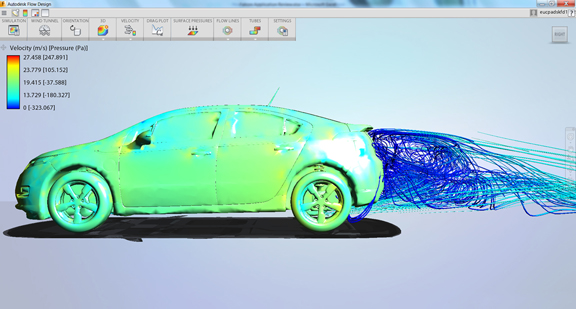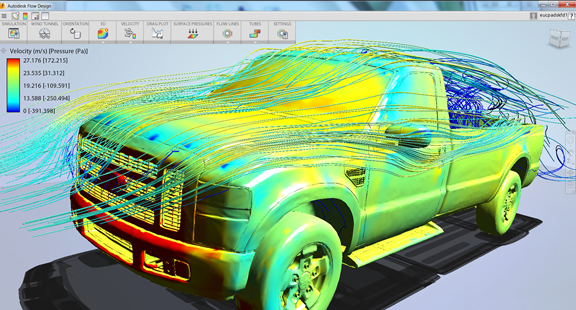January 15, 2014
Nearly two years ago, Project Falcon made its debut in Autodesk Labs, as a preview of the company’s wind-tunnel simulation technology. This week, the project becomes a bona fide product. Returning as Autodesk Flow Design, the product functions both as a standalone application (PC or Mac) or a plug-in for Autodesk Inventor (for mechanical design) and Revit (for architectural design).
Wind tunnel or airflow simulation is usually the domain of experts, a market served by high end CFD software makers. Autodesk Flow Design, however, targets designers with limited exposure to simulation. The simple wizard-like setup lets users import existing geometry and set up simulation scenarios (for instance, simulating the airflow around a vehicle traveling at a certain speed, or a stadium of a certain shape) with just a few input parameters.
With built-in visualization tools, Flow Design lets users view the simulation results in as pressure distribution, velocity plots, wind speed, and flow lines. The product supports a robust selection of simulation input formats, including STL, OBJ, and DWG.
Consistent with Autodesk’s recent push for pay-as-you-go licensing, Flow Design is offered as monthly or annual rental ($35/user/month or $210/user/year). The base product, Autodesk Inventor, is part of Autodesk Product Design suite, also offered in monthly or yearly rental licensing ($315/month or $2,500/year).
In the blog post launching the product, Autodesk PR wrote, “This type of early conceptual understanding can benefit a wide range of users, including vehicle designers that need to understand how aerodynamic performance is impacted by form changes; building designers that need to see how a cluster of new buildings might effect wind levels in the pedestrian areas connecting them; and consumer product designers who want to see how their conceptual design for, say, a golf club or a helmet, behaves in the wind.”
For detailed airflow study in a later stage of the design, a higher end CFD product would still be the preferred choice for many. However, for those seeking to study and refine their products’ shapes earlier in the development cycle, a simple, easy-to-use program like Autodesk Flow Design is a viable option.
Efforts to make simulation accessible beyond the expert circle are ongoing, led by some simulation software vendors. In the last few years, cloud-hosted simulation, or browser-based simulation, also emerged as a more affordable alternative for a wider audience. At $35 a month, Autodesk Flow Design is a low-risk, no-commitment proposition for designers who want to dabble in simulation.
For more, watch Autodesk’s video below:
Subscribe to our FREE magazine, FREE email newsletters or both!
About the Author
Kenneth Wong is Digital Engineering’s resident blogger and senior editor. Email him at [email protected] or share your thoughts on this article at digitaleng.news/facebook.
Follow DE







